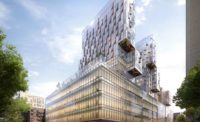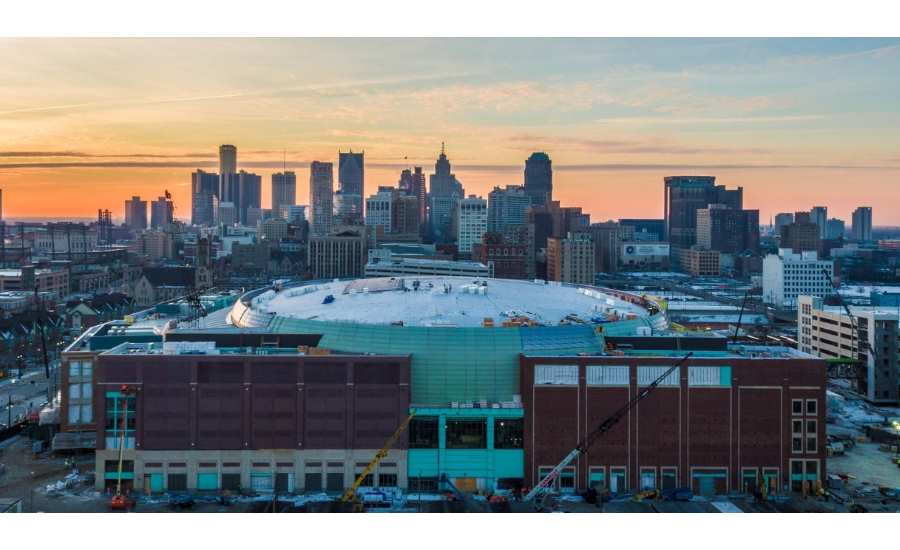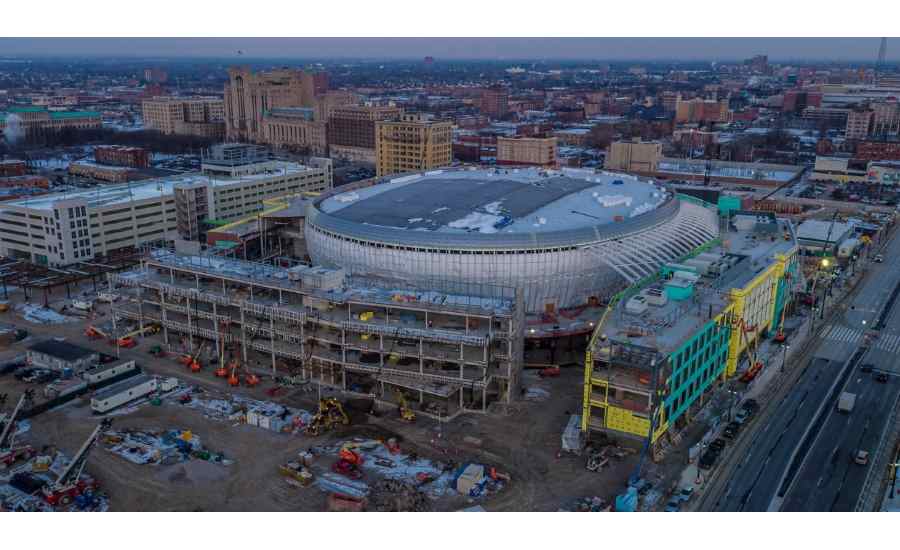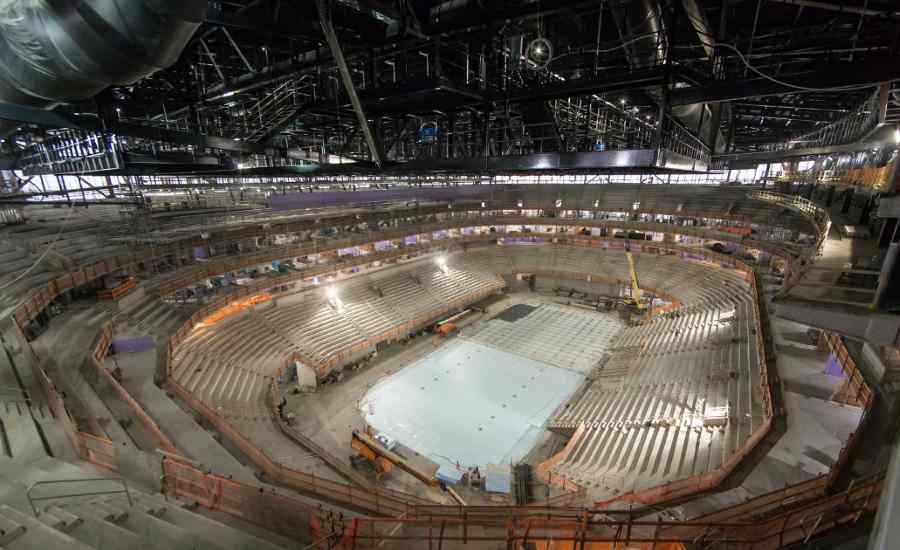Arena a Pillar of Urban Renewal








Construction teams have faced no shortage of challenges on the new Little Caesar’s Arena in the heart of downtown Detroit, from tracking sustainability for multiple buildings to creating an arena with one of the steepest bowls ever built.
For the owner, Olympia Development, the construction arm of the Ilitch family’s business network, the biggest, boldest ideas of design that went into this project are what make the new arena incomparable to any other. President and CEO of Olympia Entertainment Tom Wilson says they traveled all over the country going to different arenas, asking each about the best aspects of their own design.
“And it’s all going to be in this new arena,” he says. “We’re not the first to do what we’re doing, but we’re definitely the first to do it on this scale. The simple size of it puts us on a whole new level.”
Altogether, the arena will encompass about 895,000-square-feet, with roughly 755,000-square-feet of that being usable area.
Work officially got underway on September 25, 2014 with an initial budget of $450 million. However, the owner eventually decided to add on more enhancements, bringing the adjusted budget up to about $700 million. Despite these changes, the projected completion date is still September 1, 2017. Maximum capacity will range from 20,380 for basketball games to 19,400 for hockey and 21,400 for concert events.
Deep Setting
For the owner and the design teams, some of the ideas behind the redesign and the location change were all about preserving what is special about Joe Louis Arena, the current home of the Detroit Red Wings, says Ryan Gedney, lead designer with HOK Architects. They also aimed to bring in the feel of other older hockey venues, “in that a lot of them are really steep, really intimate and really just dense with people,” he adds.
The new arena’s seating bowl is steep enough to create an intimidating wall of people, which will make it one of the more intense venues in the National Hockey League. Additionally, the lower bowl is completely sunken below grade, 40 feet into the ground.
During excavation, workers were on-site six days a week just to dig the massive hole. More than 50 double-train trucks hauled out soil on a daily basis.
Additionally, through January 2017, just under 67,000 cubic-yards of concrete have been placed—and they’re not done yet. Currently, teams are now working seven days a week on two different shifts.
Since the lower main concourse is completely at grade, district activity and concourse activity are one in the same, right at street level. That helps to blur the inside and the outside together, which is one of the main objectives of the new arena.
“By sinking it in the ground it’s not such an opposing ‘monster on a fabric,’ which tends to be, on the lower scale, a three- to four-story building,” says Gedney. “This helps to bridge that gap so you’re not dwarfing anything around you.”
One of the main themes in the design of the new stadium was merging “old Detroit” with “new Detroit.” To achieve this look, the design teams specified 13 different colors of hand-laid brick for the exterior skin, harkening back to facades from many years ago. Cast stone is also incorporated, with the combination of materials creating an effect of seeing multiple buildings.
“This new-aged design created unique challenges that stemmed from this ‘bigger picture idea,’” says Gedney. “To do something on this level, you have to be passionate about urban planning. This often requires designing well beyond the site of your particular project. Make sure you have a smart plan for how it will integrate into the bigger fabric. Any venue has significant impacts in urban cores where they tend to be a catalyst project for urban redevelopment.”
The seating bowl alone uses materials that look to the future—clad with a custom metal façade that extends from the inside to the outside. The bowl introduces a modern jewel skin—this articulated paneling works its way around the bowl, allowing images to be projected onto it during games and concerts. The amount of detail and time that has gone into just the skin wasn’t without its own set of challenges. Since this is a rounded ovular form, it required parametric software to identify efficient ways of cladding the structure, minimizing cost and preserving the overall design intent. This step was crucial during installation.
“Having automated form finding that is more efficient and that can be directly transferred to the fabricator was key,” says Gedney. “Transferring the model allowed us to drive the fabrication directly. From the delivery standpoint, this led the charge in terms of helping us to create a more efficient delivery.”
Local Crews, Delivery Tactics
Significant effort was placed in manning this project with firms and people from Michigan.
“Over $600 million of work went to Michigan-based businesses, and $400 million of that was actually Detroit-based businesses,” Wilson says. “So a majority of the money was recirculated within our state, and has done wonders for the local economy here. We were also able to create 12,000 jobs—and that doesn’t include the jobs that are yet to come once it’s completed.”
The development will include mixed-use office space, retail buildings and a parking structure adjacent to the arena. With these four independent projects on one plot of land, all with different elevations, plus roughly 1,200 people onsite per day, logistics and planning were crucial.
For contractor Barton Malow, these challenges and time requirements have been the most critical issues. To solve this, jobs had to be bought up in packages.
“So we were buying the earth retention and the soil before the concrete was final designed,” says Sean Hollister, senior project director with Barton Malow. “Then we were buying the concrete and the steel before the skin and all the interiors were final designed. So as you’re going through you’re always doing work in a fast-tracked manner before the other components are fully developed.”
The majority of the project is design-build, but a number of aspects, due to their certain complexities—such as mechanical and electrical—have been design-assist.
“Some parts of our process were with traditional methods, some parts were design-assist methods,” Hollister says. “We even had design-build methods. So we’ve done a little of everything. It’s not a design-build contract, but for certain components it made sense to bring on these partners sooner and go through a design-assist so we could get things moving and never stop.”
The team is currently pursuing LEED certification on the project, and is recycling all waste and using continuous tracking, Hollister adds. “We know all of the components that go into each building since they are procured separately, so it’s much easier for us to track.”
Looking for a reprint of this article?
From high-res PDFs to custom plaques, order your copy today!






.png?height=200&t=1740147695&width=200)




